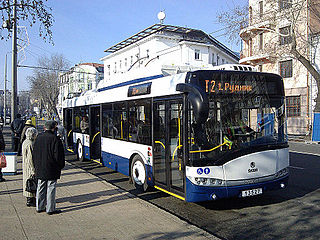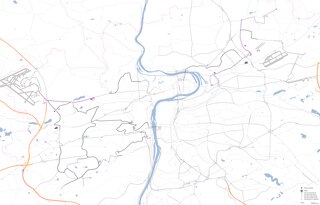| Ganja trolleybus system | |
|---|---|
| Operation | |
| Locale | Ganja, Azerbaijan |
| Open | 1 May 1955 |
| Close | 2004 |
| Status | Closed |
| Lines | 8 (max) |
| Statistics | |
| Route length | 112.9 km (70.2 mi) (max) |
The Ganja trolleybus system was a system of trolleybuses forming part of the public transport arrangements in Ganja, the second most populous city in Azerbaijan, for most of the second half of the 20th century. [1]
The system was opened on 1 May 1955. At its height, it consisted of eight lines, and had a total length of 112.9 km (70.2 mi). It was closed in 2004. [1]
During the final stages of the system's operation, only route 7 was still served by trolleybuses, during the rush hour peak period. [2]
The Ganja trolleybus fleet in the period leading up to the system's closure was made up of 9 vehicles of types Škoda 9Tr and ZiU-682. [2]
Previously, the system had used trolleybus vehicles of the following types: [1]

Multiple-unit train control, sometimes abbreviated to multiple-unit or MU, is a method of simultaneously controlling all the traction equipment in a train from a single location—whether it is a multiple unit comprising a number of self-powered passenger cars or a set of locomotives—with only a control signal transmitted to each unit. This contrasts with arrangements where electric motors in different units are connected directly to the power supply switched by a single control mechanism, thus requiring the full traction power to be transmitted through the train.

A Warsaw trolleybus system formed part of the public transport network of Warsaw, the capital city of Poland, during two separate periods. The first trolleybus system was established in 1946 and lasted until 1973. It had a maximum of 10 routes. The second system, comprising only one route, was in operation from 1983 until 1995. Between 1992 and its closure, it was operated by Zarząd Transportu Miejskiego (ZTM), in English the Public Transport Authority (Warsaw).

The first trolleybus vehicle in Russia was built in Saint Petersburg in 1902 at Frese machine-building factory. It utilised a carriage-type current collector like the early von Siemens prototypes. There was no attempt to organize passenger or cargo services at this time.

The Burgas trolleybus system forms part of the public transport network of the Black Sea city and municipality of Burgas, the fourth most populous city, and the largest and most important port, in Bulgaria.

The Yerevan trolleybus system forms part of the public transport network in Yerevan, the capital city of Armenia. Since the closure of the Gyumri trolleybus system in 2005, it has been Armenia’s only trolleybus system.

The Dayton trolleybus system forms part of the public transportation network serving Dayton, in the state of Ohio, United States. Opened on April 23, 1933, it presently comprises five lines, and is operated by the Greater Dayton Regional Transit Authority, with a fleet of 45 trolleybuses. In 2022, the system had a ridership of 1,813,600, or about 6,300 per weekday as of the fourth quarter of 2022.

The Córdoba trolleybus system is part of the public transport network in Córdoba, the capital city of Córdoba Province, Argentina.

The trolleybus system forms part of the public transport network of Varna, the third most populous city in Bulgaria.

The Plovdiv trolleybus system was a part of the public transport network of the city and municipality of Plovdiv, the second most populous city in Bulgaria.

The Ruse trolleybus system is a part of the public transport network of the city and municipality of Ruse, the fifth most populous in Bulgaria. Opened in 1988, the system currently has seven lines and forms the backbone of the city's transport system. Its approximate length is 63 km and has been designed to work with 600V DC electricity. Over the years, various models of trolleybuses have been operated in Ruse.
The Mingachevir trolleybus system was a system of trolleybuses forming part of the public transport arrangements in Mingachevir, the fourth most populous city in Azerbaijan, for about 15 years at the turn of the 21st century.
The Sumqayit trolleybus system was a system of trolleybuses forming part of the public transport service in Sumqayit, the third most populous city in Azerbaijan, for most of the second half of the 20th century.
The Nakhchivan trolleybus system was a system of trolleybuses forming part of the public transport arrangements in Nakhchivan, the capital of the eponymous Nakhchivan Autonomous Republic of Azerbaijan, for nearly 20 years from 1986.
The Baku trolleybus system was a system of trolleybuses forming part of the public transport arrangements in Baku, the capital city of Azerbaijan, for about 65 years from 1941.

The Chișinău trolleybus system forms an important part of the public transport network in Chișinău, the capital of Moldova. The system was created shortly after the end of the World War II to replace the old electric tram system that suffered extensive damage during the war. Along with the network of minibuses known as rutierele, it forms the backbone of the Chișinău transport system, with the average daily ridership reaching 250,000 passengers per day.

The Stara Zagora trolleybus system forms part of the public transport network of Stara Zagora, Bulgaria.

The production of urban electric transport is a branch of Russian engineering. Russia has the largest number of trolley (85) and tram systems (86) in the world.

The Škoda 14Tr is a Czech trolleybus that was produced from 1981 to 1998. Prototypes were built in 1972 and 1974.

Prague was the first city in Czechoslovakia to introduce modern trolleybuses. Only a few other trolleybus systems existed previously in the Czech lands – in České Velenice (Gmünd) and České Budějovice – using the same overhead system as the Electromote, the predecessor of all trolleybuses.

The Tashkent trolleybus system is a closed trolleybus system in Tashkent. Having existed for nearly 63 years, what was once Central Asia's largest trolleybus system was shut down on May 1, 2010.
![]() Media related to Trolleybuses in Azerbaijan at Wikimedia Commons
Media related to Trolleybuses in Azerbaijan at Wikimedia Commons